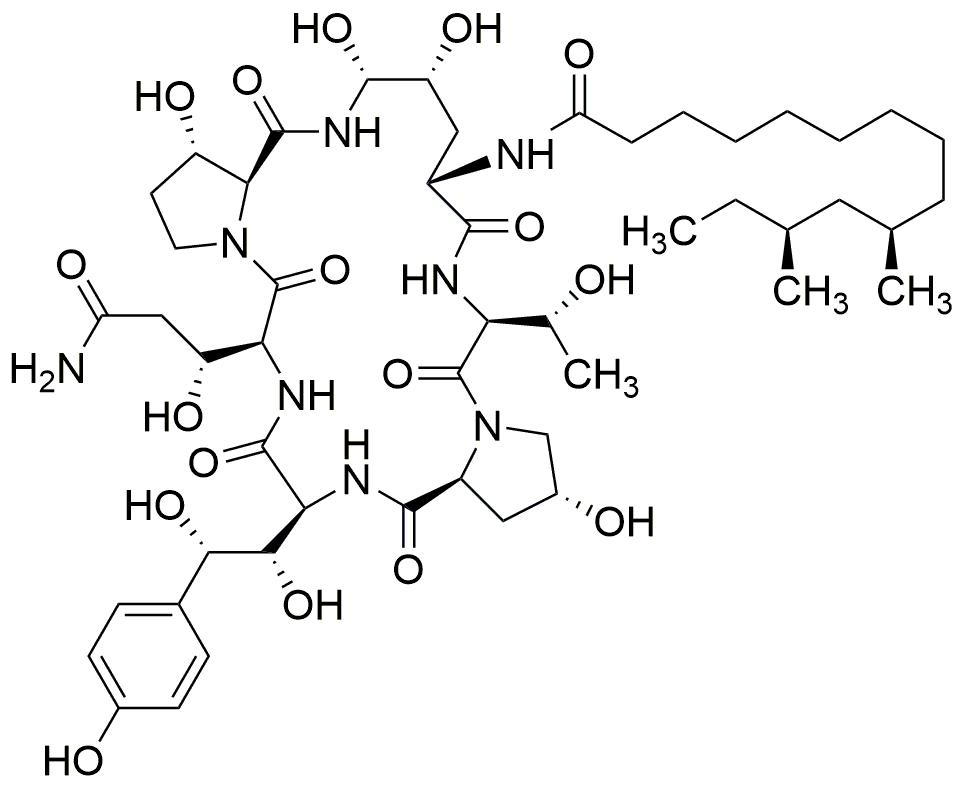Pneumocandin B0 is widely utilized in research focused on:
- Antifungal Development: This compound serves as a precursor in the synthesis of echinocandin antifungal agents, which are crucial in treating invasive fungal infections, particularly in immunocompromised patients.
- Pharmaceutical Research: It plays a significant role in drug formulation studies, helping researchers understand the pharmacokinetics and efficacy of new antifungal therapies.
- Biotechnology: Pneumocandin B0 is used in the production of biopharmaceuticals, leveraging its properties to enhance the stability and effectiveness of biologic drugs.
- Microbial Studies: Researchers utilize this compound to study the mechanisms of fungal resistance, aiding in the development of more effective antifungal strategies.
- Clinical Applications: Its derivatives are explored in clinical settings for their potential to treat various fungal infections, providing alternatives to traditional antifungal medications.
General Information
Properties
Safety and Regulations
Applications
Pneumocandin B0 is widely utilized in research focused on:
- Antifungal Development: This compound serves as a precursor in the synthesis of echinocandin antifungal agents, which are crucial in treating invasive fungal infections, particularly in immunocompromised patients.
- Pharmaceutical Research: It plays a significant role in drug formulation studies, helping researchers understand the pharmacokinetics and efficacy of new antifungal therapies.
- Biotechnology: Pneumocandin B0 is used in the production of biopharmaceuticals, leveraging its properties to enhance the stability and effectiveness of biologic drugs.
- Microbial Studies: Researchers utilize this compound to study the mechanisms of fungal resistance, aiding in the development of more effective antifungal strategies.
- Clinical Applications: Its derivatives are explored in clinical settings for their potential to treat various fungal infections, providing alternatives to traditional antifungal medications.
Documents
Safety Data Sheets (SDS)
The SDS provides comprehensive safety information on handling, storage, and disposal of the product.
Product Specification (PS)
The PS provides a comprehensive breakdown of the product’s properties, including chemical composition, physical state, purity, and storage requirements. It also details acceptable quality ranges and the product's intended applications.
Certificates of Analysis (COA)
Search for Certificates of Analysis (COA) by entering the products Lot Number. Lot and Batch Numbers can be found on a product’s label following the words ‘Lot’ or ‘Batch’.
*Catalog Number
*Lot Number
Certificates Of Origin (COO)
This COO confirms the country where the product was manufactured, and also details the materials and components used in it and whether it is derived from natural, synthetic, or other specific sources. This certificate may be required for customs, trade, and regulatory compliance.
*Catalog Number
*Lot Number
Safety Data Sheets (SDS)
The SDS provides comprehensive safety information on handling, storage, and disposal of the product.
DownloadProduct Specification (PS)
The PS provides a comprehensive breakdown of the product’s properties, including chemical composition, physical state, purity, and storage requirements. It also details acceptable quality ranges and the product's intended applications.
DownloadCertificates of Analysis (COA)
Search for Certificates of Analysis (COA) by entering the products Lot Number. Lot and Batch Numbers can be found on a product’s label following the words ‘Lot’ or ‘Batch’.
*Catalog Number
*Lot Number
Certificates Of Origin (COO)
This COO confirms the country where the product was manufactured, and also details the materials and components used in it and whether it is derived from natural, synthetic, or other specific sources. This certificate may be required for customs, trade, and regulatory compliance.


